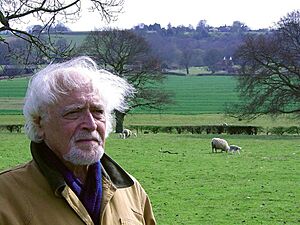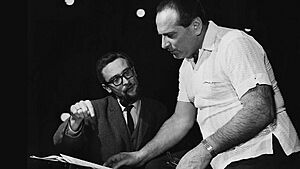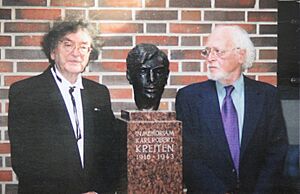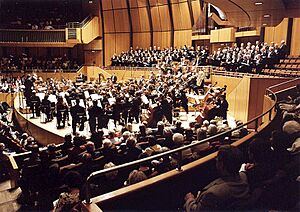Rudi Martinus van Dijk facts for kids
Rudi Martinus van Dijk (born March 27, 1932 – died November 29, 2003) was a talented composer and pianist from the Netherlands and Canada. He wrote many kinds of music, including pieces for orchestras, smaller groups (called chamber music), and voices.
His music was very original and unique. Even though he used ideas from different styles, his own voice always shone through. He was known for strong bass lines, which gave his music a clear direction. He blended intense emotions, like those found in German music, with subtle and indirect sounds, similar to French music. He was a creative artist who loved to read and think, bringing all these ideas into his compositions.
Contents
Who Was Rudi Martinus van Dijk?
Early Life and Musical Start (1938-1955)
Rudi Martinus van Dijk started playing the piano when he was six years old. In 1944, he began studying piano at the Royal Conservatory of The Hague. When he turned 18, he became a full-time student there. He studied piano, oboe, and how to compose music.
In 1953, his "Sonatina for piano" was chosen to be performed at an international music event. Later that year, he joined the Canadian Grenadier Guards Band as an oboe player. He married Jeanne Koning, and they moved to Ontario, Canada. In 1955, he also studied with the American composer Roy Harris.
Working in Canada and the United States (1955–1982)
In the 1950s and 60s, Van Dijk composed music for educational TV shows. He also played piano live on the radio for the Canadian Broadcasting Corporation (CBC). The CBC later asked him to write a piece called Four Epigrams for Symphony Orchestra (1962). This piece was performed by the CBC Symphony for a school broadcast. It was designed to help young listeners understand music with its strong rhythms and dramatic sounds.
The Canada Council helped Van Dijk study composition in Paris from 1964 to 1965. There, he learned from Max Deutsch, who was a student of the famous composer Arnold Schoenberg. He also finished his piano studies in London. From 1964 to 1966, Van Dijk worked for the British Broadcasting Corporation (BBC) on educational TV shows.
In 1966, he returned to Canada and started teaching piano at the Royal Conservatory of Music in Toronto. The CBC asked him to write a cantata (a type of vocal music) called Now is the Prophet's Time (1967). It was first performed in the Netherlands for Dutch radio.
In 1972, Van Dijk joined the Faculty of Music at Indiana University. His piece Immobile Eden (1972) was first performed in New York City in 1975. From 1975 to 1981, he taught at Berklee College of Music in Boston. During this time, his Movement for Alto saxophone and piano (1960) was first played.
His Concertante for Flute, Harp, Percussion and Strings (1963) was first performed in Toronto in 1964 and shown live on CBC television. The famous French flutist Jean-Pierre Rampal praised the piece. It has been played many times in Canada, Finland, and the United States.
In 1978, the Toronto Symphony Orchestra performed Van Dijk's The Shadowmaker (1977). This work was inspired by poems by Canadian poet Gwendolyn MacEwan. Van Dijk said he was drawn to the poems because they explored dreams and reality. Music experts noted that this piece showed a bold and expressive side, similar to composers like Berg and Schoenberg, but still kept Van Dijk's unique style.
In 1982, Van Dijk's son Felix's fiancé sadly passed away. On that day, Van Dijk started composing a violin concerto in her memory. This Violin Concerto (1984) was first performed in 1991 in the Netherlands. Some people compare it to Alban Berg's Violin Concerto because of its sad tone and emotional bursts.
Return to Europe and Later Years (1985–2003)
In 1985, Van Dijk and his wife moved back to Europe. He spent a year focusing on his music in Casares, Málaga, Spain. After that, he became a composer-in-residence and taught piano and composition at Dartington Hall in Devon, United Kingdom.
His Irish Symphony (1990) was commissioned to celebrate Dublin as the European Capital of Culture in 1991. It was broadcast on Irish radio. The Four Epigrams for Symphony Orchestra (1962) had its European premiere in 1993. His The Piano Concerto (1994) was first performed in 1996.
In the United Kingdom, the Raphael Ensemble asked him to write his String Sextet, which they first performed in 1998. That same year, violinist Anthony Marwood asked him to write his Sonata for Violin and Piano, which was first played at London's Wigmore Hall.
In 2003, a concert was held in London to celebrate Van Dijk's 70th birthday. It featured performances of his music, including the first performance of his Songs of the Tao te Ching.
In 2000, Indian dancer Mayuri Boonham asked Van Dijk to compose The Triple Hymn. This piece was based on a mantra (a sacred sound or word) from ancient Indian texts. It was written for cello, soprano, and percussion instruments, and it explored different cultures and sounds.
In 2001, the Florestan Trio performed Van Dijk's Piano Trio (2001) at the Concertgebouw in Amsterdam. They had asked him to write this piece for a festival.
In 2002, the Düsseldorfer Symphoniker asked Van Dijk to write a large piece for voices and orchestra. This piece was to honor Karlrobert Kreiten, a talented German-Dutch pianist. Kreiten's life was cut short when he was reported to the Gestapo (the secret police in Nazi Germany) for speaking negatively about Adolf Hitler. He was arrested and executed in 1943.
Van Dijk spent his last year, 2003, completing this piece, which he called Kreitens Passion. He was able to attend all three first performances of the work in October 2003. Rudi Martinus van Dijk passed away a month later, on November 29, 2003.
He is remembered by his wife, Jeanne, and his two sons, Felix and Walter. The Rudi Martinus van Dijk Foundation is a charity that helps young composers and conductors in areas facing political or economic challenges.
Notable Works
- Four Epigrams for Symphony Orchestra (1962)
- Concertante for Flute and String Orchestra (1963)
- A Christmas Cantata (Now is the Prophet's Time) for solo tenor, school choir, mixed choir and orchestra (1967)
- Immobile Eden for soprano, flute and piano (1972)
- The Shadowmaker, four pieces for baritone and orchestra (1977)
- Concerto for violin and orchestra (1984)
- Irish Symphony in four movements for orchestra (1990)
- Concerto for piano and orchestra (1994)
- Kreiten's Passion for baritone, choir and orchestra (2003)
Chamber Works
- Sonatina for piano (1951)
- Sonata for Clarinet and piano (1955)
- Two Lieder for soprano and piano (1958)
- Movement for Alto saxophone and piano (1960)
- Le tombeau de Francis Poulenc : for piano four hands or 2 pianos, 1965 (1964)
- Bagatelle for piano (1969)
- Lament for a Dying Bird: Three pieces for solo clarinet (1979)
- Incantation for solo flute (1982)
- Sonata for Violin and piano (1995)
- Two pieces with interlude : for soprano, flute/piccolo/bass flute and piano (1995)
- Red, white and blues : Dutch new blues pieces, for piano (1996)
- String Sextet (1997)
- A touch of the Blues : for piano solo (1998)
- String Quartet in five movements (1999)
- Piano Trio : for violin, violoncello and piano (2001)






